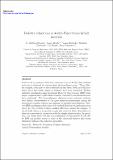Por favor, use este identificador para citar o enlazar a este item:
http://hdl.handle.net/10261/136369COMPARTIR / EXPORTAR:
 SHARE SHARE
 CORE
BASE CORE
BASE
|
|
| Visualizar otros formatos: MARC | Dublin Core | RDF | ORE | MODS | METS | DIDL | DATACITE | |

| Campo DC | Valor | Lengua/Idioma |
|---|---|---|
| dc.contributor.author | Martínez-Rugerio, G. | - |
| dc.contributor.author | Alegría, Ángel | - |
| dc.contributor.author | Colmenero de León, Juan | - |
| dc.date.accessioned | 2016-09-06T07:52:20Z | - |
| dc.date.available | 2016-09-06T07:52:20Z | - |
| dc.date.issued | 2015 | - |
| dc.identifier | doi: 10.1016/j.polymer.2015.07.055 | - |
| dc.identifier | issn: 0032-3861 | - |
| dc.identifier.citation | Polymer 74: 21-29 (2015) | - |
| dc.identifier.uri | http://hdl.handle.net/10261/136369 | - |
| dc.description | et al. | - |
| dc.description.abstract | In this work we present a dielectric relaxation study of Acrylic/Polyurethane polymers synthesized via miniemulsion photo-polymerization. Three different samples, both parts of the synthesized hybrid latex (SOL and GEL fractions) and a full acrylic sample as reference have been considered. Besides dielectric experiments using Broadband Dielectric Spectroscopy (BDS) technique, complementary Differential Scanning Calorimetry measurements have been performed. The thermodynamic characterization outcomes evidence very similar characteristics of the glass transition phenomena among the investigated samples without any signature of melting/crystallization. However BDS experiments show three well resolved dielectric relaxation processes above Tg, two of them evidence marked differences among the samples. A detail study allows us to provide a molecular origin for these three dielectric relaxation processes in connection with the sample characteristics. In particular, our results show that the characterization of these hybrid Acrylic/PU by BDS can provide access to some of the structural features that would ultimately influence the adhesives properties. | - |
| dc.description.sponsorship | The authors gratefully acknowledge the financial support of the Basque Government project codes: IT-654-13 and nanoIKER-2011-2013 (Etortek program) and also the Spanish “Ministerio de Economía y Competitividad” and EU, project code: MAT2012-31088. | - |
| dc.publisher | Elsevier | - |
| dc.relation.isversionof | Postprint | - |
| dc.rights | openAccess | en_EN |
| dc.subject | Dielectric relaxation | - |
| dc.subject | Polymer dynamics | - |
| dc.subject | Acrylic/Polyurethane hybrids | - |
| dc.title | Dielectric relaxations of Acrylic-Polyurethane hybrid materials | - |
| dc.type | artículo | - |
| dc.identifier.doi | 10.1016/j.polymer.2015.07.055 | - |
| dc.relation.publisherversion | http://dx.doi.org/10.1016/j.polymer.2015.07.055 | - |
| dc.date.updated | 2016-09-06T07:52:21Z | - |
| dc.description.version | Peer Reviewed | - |
| dc.language.rfc3066 | eng | - |
| dc.rights.license | http://creativecommons.org/licenses/by-nc-nd/4.0/ | - |
| dc.contributor.funder | Eusko Jaurlaritza | - |
| dc.contributor.funder | European Commission | - |
| dc.contributor.funder | Ministerio de Economía y Competitividad (España) | - |
| dc.relation.csic | Sí | - |
| dc.identifier.funder | http://dx.doi.org/10.13039/501100000780 | es_ES |
| dc.identifier.funder | http://dx.doi.org/10.13039/501100003329 | es_ES |
| dc.identifier.funder | http://dx.doi.org/10.13039/501100003086 | es_ES |
| dc.type.coar | http://purl.org/coar/resource_type/c_6501 | es_ES |
| item.openairetype | artículo | - |
| item.grantfulltext | open | - |
| item.cerifentitytype | Publications | - |
| item.openairecristype | http://purl.org/coar/resource_type/c_18cf | - |
| item.fulltext | With Fulltext | - |
| Aparece en las colecciones: | (CFM) Artículos | |
Ficheros en este ítem:
| Fichero | Descripción | Tamaño | Formato | |
|---|---|---|---|---|
| Acrilyc-Polyurethane.pdf | 5,42 MB | Adobe PDF |  Visualizar/Abrir |
CORE Recommender
SCOPUSTM
Citations
10
checked on 10-abr-2024
WEB OF SCIENCETM
Citations
8
checked on 25-feb-2024
Page view(s)
202
checked on 19-abr-2024
Download(s)
305
checked on 19-abr-2024
Google ScholarTM
Check
Altmetric
Altmetric
Este item está licenciado bajo una Licencia Creative Commons

